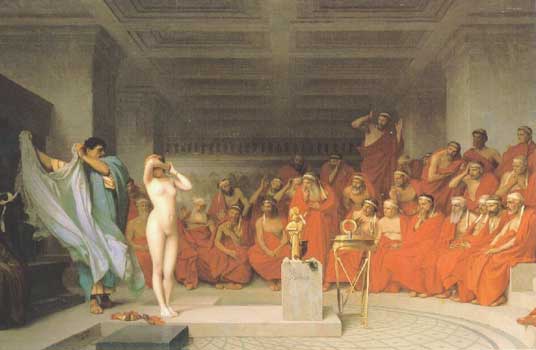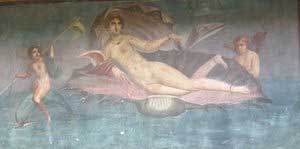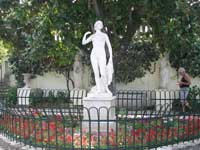.


Henryk Siemiradzki. Phryne at the Festival of Poseidon in Eleusin. Details. 1889. Oil on canvas. The Russian Museum, St. Petersburg, Russia.
Phryne once asked of him the most beautiful of his works, and the story goes that lover-like he agreed to give it, but refused to say which he thought the most beautiful. So a slave of Phryne rushed in saying that a fire had broken out in the studio of Praxiteles, and the greater number of his works were lost, though not all were destroyed. Praxiteles at once started to rush through the door crying that his labour was all wasted if indeed the flames had caught his Satyr and his Love. But Phryne bade him stay and be of good courage, for he had suffered no grievous loss, but had been trapped into confessing which were the most beautiful of his works. So Phryne chose the statue of Love; while a Satyr is in the temple of Dionysus hard by, a boy holding out a cup. Pausanias
Phryne (Φρύνη) was a famous hetaera of Ancient Greece (390-330 BC) who adjusted her prices for customers depending upon how she felt about them. When the King of Lydia wanted her favors she named a truly absurd price because she considered him loathsome; he paid the price and then levied a tax on his subjects to raise the sum. On the other hand, she gave herself to the philosopher Diogenes for free because she admired his mind.

Phryne before the judges , Jean-Léon Gerôme, 1861, Hamburger Kunsthalle, Germany

“Phryne Before the Chicago Tribunal”, Cartoonist: Bernhard Gillam, Source: Puck. Date: June 4, 1884, p. 137
Famously, when she appeared in court she avoided conviction by lowering her robe and revealing her flawless breasts. The judges relented and let her off —not because they were overcome by her body, but because physical beauty was often seen as a facet of divinity or a mark of divine favor.

This mural from Pompeii is believed to be based on Anadyomene Venus, a lost painting by Apelles.

Phryne and Praxiteles ( Source)
Praxiteles was commissioned to make a statue of her, the Aphrodite of Knidos. She is also said to have been the model for the Aphrodite Anadyomene of Apelles.
Dimitris Varos Greek poet writer of the book Phryne.
Audfray Etienne Phryne sculpture

Phryne on the Poseidon"s celebration in Eleusis, Nikolay Pavlenko, Oil on Canvas, 91cm x 131 cm. Nikolay Pavlenko, 1894

Phryne, Jose Frappa

Phryne Going to the Public Baths as Venus: Demosthenes Taunted by Aeschines

Phyrne, Achilleion, Corfu. Phryne shows that her body is a good model for Aphrodite

Phryne at Eleusis, Frederic Lord Leighton

See also
| Ancient Greece
Science, Technology , Medicine , Warfare, , Biographies , Life , Cities/Places/Maps , Arts , Literature , Philosophy ,Olympics, Mythology , History , Images Medieval Greece / Byzantine Empire Science, Technology, Arts, , Warfare , Literature, Biographies, Icons, History Modern Greece Cities, Islands, Regions, Fauna/Flora ,Biographies , History , Warfare, Science/Technology, Literature, Music , Arts , Film/Actors , Sport , Fashion --- |
Retrieved from "http://en.wikipedia.org"
All text is available under the terms of the GNU Free Documentation License


